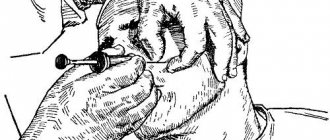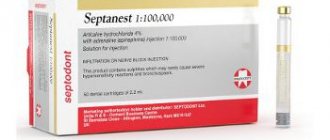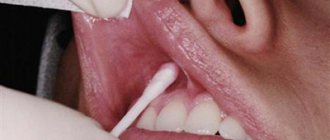Types of anesthesia in dentistry
Anesthesia in dentistry can be general or local. The first includes intravenous sedation, as well as general anesthesia. That is, the drugs do not act locally in the oral cavity, but throughout the entire body. Actually, this is ordinary general anesthesia, which is used everywhere in medicine - it’s just that certain types are used in dentistry. Local, as it is already becoming clear, includes the familiar “freezing”, which is administered by injection.
Separately, we can also distinguish xenon sedation or xenon therapy - the second name will be even more correct, since such anesthesia is used to prepare for local or general anesthesia. It allows you to reduce the level of anxiety and stress, saturates the body's cells with oxygen, due to which it has a general healing and even rejuvenating effect! It is not an independent type of pain relief, but is used in combination with other approaches.
Advantages
The preference for using this method in dentistry is due to the following advantages:
- the ability to block sensitivity over a large area of the jaw for the alternate removal of several units of the dentition, opening purulent abscesses;
- the need to use a small amount of the drug compared to alternative methods of pain relief.
It is worth highlighting a number of advantages associated with minimizing the likelihood of complications:
- reduced risk of developing neuropathic syndromes;
- there is no possibility of the solution penetrating into the vessels;
- improving the quality of blocking the sensitivity of nerve endings;
- high efficiency for operations of any complexity.
Indications
Conduction anesthesia is performed before the following therapeutic measures:
- simultaneous extraction of several units of the dentition located in one area of the oral cavity;
- removal of tooth roots with inflammatory processes;
- removal of pathological teeth (for example, those that have grown into the gums);
- implantology (used for painless implantation);
- surgical intervention on the lower molars (molars);
- treatment of inflammation in the maxillofacial region;
- elimination of inflammation on mucous membranes and soft tissues;
- treatment of complex carious cavities;
- with intolerance to general anesthesia.
Maxillary anesthesia
- Palatal method. Allows you to completely block sensitivity in the palate area, making any manipulation absolutely painless. The action of the anesthetic spreads simultaneously to the alveolar process.
- Tuberal. This technique is used for operations or extraction of molars.
- Infraorbital. Suitable for treating canines, premolars, and incisors.
- Incisive. Anesthesia is injected into the mucosal area located between the incisors and canines.
Mandibular anesthesia
- Mental way. It is carried out for the treatment of premolars, incisors, and canines.
- Mandibular. It involves blocking all units of the dentition on the side where the drug is administered.
- Torusal. Involves the introduction of a solution into the roller of the movable jaw, called the torus. Allows you to block pain symptoms in the area of premolars, as well as molars.
There is another Bershe Dubov method. It is used for maxillofacial surgical interventions. Anesthesia applies to all elements on one side. The needle can be inserted intraorally or extraorally.
Restrictions
Before choosing a pain relief method, it is important to exclude contraindications. These include:
- some operations performed on patients under 12 years of age;
- disturbance of the psycho-emotional state in a pronounced form;
- skin diseases in the area of intervention;
- allergic reactions to antiseptics;
- patients with congenital deaf-muteness;
- inability to establish contact with the patient.
Xenon sedation or xenon therapy to prepare for main anesthesia
This is a separate type of anesthesia that can be used in combination with both local and general anesthesia (if necessary). Xenon is an inert gas that quickly begins to act and is just as quickly eliminated from the body. It has a relaxing effect: anxiety decreases, the patient relaxes. Moreover, during the operation he is fully conscious, can communicate with the doctor, and understands everything that is happening around him. The procedure can be interrupted if necessary if there is discomfort. At the same time, local anesthetics are used, since xenon itself does not have a pronounced analgesic effect.
Among the pleasant “bonuses” are saturation of cells with oxygen and restoration of metabolic processes. That is, this is not only a reduction in stress, but also a general improvement in the body’s health.
Drugs used
The success of conduction anesthesia depends not only on the technique used, but also on the drugs used. The following medications are used for this pain relief technique:
- Solutions of the Articaine series. They have a long lifespan and high efficiency. These include:
- Ultracaine.
- Septanest.
- Ubistezin.
- Lidocaine. It is a highly effective anesthetic and at the same time contains a minimal amount of toxic substances.
- Melivacaine. The duration of action of this drug is about 40 minutes. Melivacaine has no contraindications for use.
- Novocaine. This is perhaps the most frequently used remedy. It is characterized by low toxicity and rapid hydrolysis in the body.
General anesthesia in dentistry
With general anesthesia, the patient falls asleep for 1-2 hours or more, i.e. for the entire duration of treatment. The drug is administered intravenously, less often by inhalation. If possible, general anesthesia should still be avoided, since its effect on many organs is quite toxic. Even despite the fact that dentistry uses “lighter” drugs than during complex surgical operations. This is a fairly large load on the body, especially on the heart, nervous and cardiovascular systems.
Intraligamentary anesthesia
Intraligamentary anesthesia is also called intraligamentous and intraperiodontal. Its difference is in higher pressure when administering an anesthetic, which ensures uniform spreading of a small amount of the drug in the periodontal space, as well as its penetration into the intraosseous space. Drugs should be administered very slowly. When using this type of anesthesia, significantly less drug is required than with conventional infiltration; it occurs within 15-45 seconds and lasts for 20-30 minutes. For intraligamentary anesthesia, special syringes are often used, which make it possible to administer the drug under the required pressure without unnecessary effort and thus achieve the best result.
Intravenous sedation
Intravenous sedation does not have such pronounced negative consequences for the body. Softer and gentler drugs are used here. Sedation puts a person into a half-asleep state - the patient can respond to the doctor’s commands, communicate and understand him. At the same time, the person is completely relaxed and may even fall asleep for several hours. Thus, intravenous sedation is a more gentle and safe type of pain relief.
This is interesting! The word “sedation” itself means “calming.” It can be carried out either by inhalation (nitrous oxide or safer and more effective xenon is used for this), as well as intravenously with the selection of drugs strictly individually.
We treat without pain and discomfort!
Intravenous sedation
Safe and pain-free Treatment in your sleep Quick recovery from RUB 8,000. from 8,000 rub.
Xenon sedation
Relaxation before treatment No stress on the body Recovery in 2-3 minutes from RUB 5,000. from 5,000 rub.
With us you will stop being afraid of dentists! Individual selection of drugs, the most modern equipment and certified doctors who professionally work with all types of anesthesia.
Enroll now
Use in dental practice
An anesthetic drug is injected into an area located a short distance from the site where surgery will be performed.
Conduction anesthesia can be performed in one of two ways:
- Central. The doctor determines the main trunks of the nerve endings for subsequent administration of the medicine into one of them.
- Peripheral. The anesthetic is injected into one of the branches of the main nerve of the stem system.
High-quality pain relief involves delivery of the solution to its destination. We are talking about a canal - a bone opening through which the nerve ending passes.
What is local anesthesia?
Local anesthesia allows you to numb the specific area where the intervention is planned. The patient is conscious. And this is actually more than enough even for complex surgical operations.
For local administration of all types of anesthetics, special reusable syringes are used, which have a recess for inserting a carpule - this is a hermetically sealed ampoule with an anesthetic. Unlike disposable ones, carpule syringes have a thinner needle, which allows you to administer the drug slowly and thus eliminate pain. All syringes for reusable use must undergo antiseptic treatment and sterilization using modern ultrasonic and temperature sterilization equipment.
Computer anesthesia
Computer anesthesia allows dentists to calculate more accurate doses of the drug, administer it at the desired speed, pre-selected by the computer, and painlessly guide the syringe needle, which has a special cutting edge. Anesthesia administered with high precision can last longer - up to 40 minutes, and visual and audio signals provided by the device allow the doctor to position the needle as needed, without the risk of tissue damage, introducing anesthetic into the bloodstream or placing the needle too far from the nerve.
Infiltration anesthesia
Classic “freezing”, which is used in dentistry for almost any manipulation. The drug is injected under the mucosa, into the periosteum or directly into the bone. Depending on the procedure and the patient’s pain threshold, the required dosage is selected - for example, in case of acute pulpitis or complex tooth extraction, a higher concentration of the drug is used. If the patient is afraid of injections, topical anesthesia can additionally be used to numb the site of needle insertion, or xenon sedation.
When performing the procedure, the doctor must take into account the anatomy of the jaw system. For example, in the lower jaw the alveolar bone is denser, so anesthesia is less effective. In the upper jaw, when performing manipulations in the area of wisdom teeth, there is a risk of the needle touching one of the branches of the facial nerve, which is fraught with the development of neuralgia. The clinic’s doctors have the necessary qualifications, so even the most complex anesthesia is performed completely safely for the patient.
Tuberal anesthesia
Tuberal anesthesia is so named in connection with the injection site - the tubercles of the upper jaw, which are called tuber in Latin. The posterior alveolar nerves are located here, innervating the area of the alveolar ridge from the third to the first molar. This type of anesthesia is the most dangerous in terms of possible complications due to individual differences in the structure of this area and the location of nerves and blood vessels in it. There are intraoral and extraoral methods of administering tuberal anesthesia. It is believed that the intraoral method is more likely to cause injury, while the external method is safer and it is also easier to ensure adequate antiseptic treatment of the surface before injection.
Preparations for local anesthesia
The Smile-at-Once clinic uses modern anesthetics of the latest generation - effective, non-toxic and absolutely safe, even for pregnant women, the elderly or children. We do not use drugs based on novocaine or lidocaine due to toxicity and a high risk of allergic reactions. In addition, the articaine group of drugs, which are used today for local anesthesia, are 5-6 times more effective than lidocaine.
"Ultracaine" for all groups of patients
An original drug produced in France, which is used for both infiltration and conduction anesthesia.
It is safe, used even in the presence of allergic reactions, and is suitable for patients with heart disease and pregnant women. Its effectiveness is very high, while it is instantly eliminated from the body and does absolutely no harm. The main active ingredient is articaine, to which epinephrine is added to enhance the anesthetic and prolong its action. It provides local vasoconstriction, which significantly shortens the rehabilitation period after treatment. Depending on the concentration of epinephrine, there are three types of the drug - for different manipulations and categories of patients.
"Ultracaine-Forte" (concentration 1:100,000) is a drug with a high dose of epinephrine, used during surgical operations. "Ultracaine DS" with a low concentration (1:200,000) - is used for therapeutic treatment, including in patients with diseases of the cardiovascular system, high blood pressure, suitable for pregnant and lactating women. Ultracaine D does not contain epinephrine. The effect of the drug is short, but it can be used for allergic reactions, bronchial asthma, and pronounced cardiovascular pathologies.
"Ubistezin"
A cheaper, but no less high-quality analogue of Ultracain, produced by the German company 3M. It contains similar active ingredients: articaine hydrochloride and epinephrine. It has two forms of release, depending on the concentration of the latter (1:100,000 or 1:200,000). Use is allowed during breastfeeding and cardiovascular pathologies.
"Artikain"
An injection solution that consists directly of the main active ingredient - articaine. Inexpensive drug made in Russia. Used for infiltration or conduction anesthesia. Can be used in pure form or with the addition of epinephrine/glucose solution in a certain proportion. Not used for bronchial asthma and severe allergic reactions.
"Scandonest" for the elderly
The main active ingredient of this French-made drug is mepivacaine hydrochloride. It is not used during pregnancy and bronchial asthma, but use is allowed in patients with cardiovascular pathologies, since the drug does not contain epinephrine, adrenaline and preservatives. Suitable for older people, especially those with high blood pressure. It is one of the safest anesthetics for both infiltration and conduction anesthesia. Its disadvantage is its short duration of action, which requires repeated administration of the drug approximately every 30 minutes during long procedures.
"Orablock"
Another drug, the main active ingredients of which are articaine and epinephrine with varying concentrations of the latter, which affects the effect and duration of pain relief. Not used during pregnancy and pronounced cardiovascular pathologies.
"Naropin" for complex surgical operations
A long-acting anesthetic whose main active ingredient is ropivacaine hydrochloride. The duration of pain relief depends on the dosage. Very often, this drug is used for conduction anesthesia during complex surgical operations and the installation of a large number of implants. Among the contraindications is only individual intolerance to amide anesthetics.
Modern drugs for anesthesia
The choice of anesthetic depends on the patient's individual treatment plan and the method of anesthesia. For local topical anesthesia, gels, ointments and sprays based on lidocaine, dicaine, bumecaine, and benzocaine are currently used. For example, diplen - LH, topex gel, disilane, diseptin, xylonor.
For injection anesthesia, drugs such as procaine, lidocaine, mepivacaine, ultracaine, ubistezin, trimecaine, articaine, chirocaine, bipuvacaine are used. Inhalational sedation uses a mixture of nitrous oxide and oxygen. If you are afraid of visiting the dentist, you can take tranquilizers orally in the form of tablets, for example, diazepam, oxazepam, hydroxyzine, hexobarbital, as prescribed by the doctor.
Indications and advantages of local anesthesia
Since local anesthesia is used everywhere, the indications for its use are very wide. Modern drugs are of very high quality and completely safe (especially if you use them thoughtfully, having first collected a high-quality anamnesis about the patient’s health condition). The level of stress from treatment without anesthesia, and especially with acute pain, can be prohibitive - very often after this, patients refuse to visit the dentist, causing dental problems. Do not be afraid of anesthesia - you will not receive such a “dose” of the drug that will harm you, even if you have to treat your teeth for several days in a row.
Indications for local anesthesia
- removal of dental plaque,
- dental treatment of any complexity,
- performing plastic surgery on gums,
- tooth extraction,
- surgical operations in the oral cavity,
- preparation and implementation of dental implantation.
Advantages
- complete relief of any painful sensations,
- safety, no toxic effects on the body,
- rapid elimination from the body,
- minimum side effects,
- the choice of drug based on the health status and age of the patient.
Contraindications to anesthesia
Contraindications to local anesthesia in dentistry: allergies to any drug, cardiovascular and endocrine diseases, bronchial asthma, liver failure, taking beta-blockers, tricyclic antidepressants, mental illness, recent coronary bypass surgery, trauma to the maxillofacial area .
Temporary contraindications to dental operations under anesthesia:
- drinking alcohol on the day of surgery or the day before;
- colds;
- period of menstruation in women due to deterioration of blood clotting.
Anesthesia for bronchial asthma
in dentistry requires special knowledge and training from the doctor. This is one of the cases when safe anesthesia in dentistry is necessary.
If a patient with bronchial asthma needs dental treatment, before starting the procedures, the dentist will refer him to an allergist to clarify the status and contraindications. It is necessary to clarify what medications the client is using. In this case, before treatment, premedication is mandatory, either as prescribed by the allergist, or, in the absence of these, with Xezazal 5 mg, Zyrtec 10 mg or Kestin 10 mg 5 days before surgery, on the day of admission and 5 days after, 1 tablet 1 once a day. Immediately before dental procedures, you need to inhale a fast-acting drug from the salbutamol or fenoterol group (Ventolin, Berotec).
If an attack of suffocation develops, at the beginning of which chest pain, coughing or sneezing appears, then the inhalation shortens, the exit lengthens, wheezing is heard, the patient becomes anxious and cannot speak. The patient leans forward, rests his elbows on his knees, turns pale, sweats, and his lips turn blue. Exhalation is difficult. During an attack, the doctor should open the windows to allow fresh air in, if there is contact with the allergen, exclude it, give warm water to drink, and help inhale the medicine from the inhaler.
For bronchial asthma, an anesthetic without preservatives, for example, Ultracaine D, is best suited. Acetylsalicylic acid and other substances that provoke bronchospasm, such as morphine and indomethacin, are contraindicated.
Are there any disadvantages to local anesthesia?
Local anesthesia has virtually no disadvantages. Unlike drugs that were used previously, modern anesthetics are absolutely safe, have a minimum of contraindications, are quickly eliminated from the body, and do not have a negative effect on the heart, kidneys and liver. With professional administration, the patient will not feel any pain even during long surgical procedures.
“Our clinic uses a strictly individual approach. We have selected several of the most effective and safe drugs - for each patient we select our own method, drug and its concentration, based on individual characteristics. Therefore, everyone who undergoes treatment, implantation or prosthetics at the Smile-at-Once clinic can feel completely safe.”
Zhilenko Evgeniy Aleksandrovich, Implant surgeon, periodontist, orthopedist Work experience over 18 years make an appointment
Peripheral anesthesia
Infraorbital anesthesia
The purpose of anesthesia is to block the peripheral branches of the infraorbital nerve. The superior dental plexus consists of the superior alveolar nerves (anterior and middle), which are connected to the teeth, gums, periosteum and bones.
Infraorbital anesthesia is injected into the infraorbital opening. Intraoral and extraoral administration is possible. The extraoral method involves injecting an anesthetic through the cheek into the infraorbital opening and canal. Such anesthesia allows you to treat incisors, canines, and premolars without discomfort.
The intraoral method involves inserting a needle through the transitional fold between the roots of the central and lateral incisors (upper). In this way, it is impossible to get the needle into the infraorbital canal, so pain relief occurs with the diffusion of the anesthetic.
When performing infraorbital anesthesia, there is a risk of damaging blood vessels, which will lead to a hematoma. The size of the hematoma will depend on the degree of damage, as well as the structure of the tissue in which the hemorrhage occurred. With pathologies of blood clotting and blood pressure, such a complication can be serious.
If the doctor traumatized the nerve trunk with a needle, post-traumatic neuritis is possible. When the needle enters the eye socket through the canal, diplopia develops (doubling of visible objects). Rough impact can damage the eyeball. When an anesthetic gets into the eye socket, swelling of the lower eyelid occurs and the muscles of the nerves of the eye are anesthetized. Sometimes limited skin ischemia (insufficient blood supply) develops.
Tuberal anesthesia
Other parts of the superior dental plexus, the posterior superior alveolar nerves, exit through canals in the tubercle of the maxilla (the posterior surface of the maxillary bone). These nerves transmit signals from the molars of the alveolar process, its mucosa and some sinuses.
Extraoral tuberal anesthesia involves the injection of an anesthetic into the area of the posterior surface of the zygomatic-alveolar ridge, along the upper jaw. After 5-10 minutes, anesthesia of the upper alveolar nerves occurs.
The intraoral method of tuberal anesthesia involves inserting a needle below the fold above the second molar, or behind the zygomatic-alveolar ridge. The needle is moved to the bone, along the upper jaw. To avoid damaging the vessels, the doctor releases the anesthetic as the needle advances, displacing them. Thus, the upper molars and the mucous membrane of the alveolar process are deprived of sensitivity.
A complication of tuberal anesthesia can be damage to the vessel and the formation of a hematoma. This happens especially often with intraoral anesthesia. When using products with the effect of constricting blood vessels, the face may turn pale.
Plexual anesthesia
The superior dental plexus is represented by the connection of the anterior, middle and posterior alveolar nerves. It is located in the alveolar process above the roots of the teeth. To anesthetize this area, a needle is inserted into the movable part of the mucous fold and advanced to the bone above the lateral incisor and canine, first and second premolars.
With this needle position, the anesthetic is injected very slowly and carefully. This is due to the sensitivity of nearby tissues, which can be easily injured and cause pain. Plexual anesthesia is well suited for the removal of incisors, canines, first and second premolars.
Palatinal anesthesia
This anesthesia is required to numb the greater palatine nerve, which is part of the pterygopalatine ganglion. The palatine nerve exits through the greater palatine foramen, branches to the mucous membrane of the hard and soft palate, and the alveolar process on the palatine side.
The needle is inserted 10 mm in front of the greater palatine foramen, advanced to the bone, but not inserted into the bone canal, since the introduction of the drug even near the foramen ensures an effect. With palatal anesthesia, bleeding from a damaged vessel is possible, followed by the occurrence of a hematoma. Sometimes partial paralysis of the soft palate occurs. When the anesthetic compresses the blood vessels, the mucous membrane may turn pale. If another liquid is mistakenly introduced into the cavity, necrosis is possible.
Incisal anesthesia
The nasopalatine nerve is a branch of the pterygopalatine fascicle that exits through the incisive foramen and provides sensitivity to the anterior teeth. For extraoral administration, the needle is advanced into the nasolabial recess, the anesthetic is injected 2 cm from the nasal septum and 1 cm down from the pyriform opening.
When administered intraorally, the needle is placed at the base of the incisive papilla to anesthetize the mucous membrane of the frontal teeth or advanced into the canal a centimeter to achieve loss of sensitivity of the teeth themselves. In this way, the mucous membrane of the hard palate near the incisors and fangs is anesthetized.
Complications of incisal anesthesia may include bleeding, ischemia of the mucous membrane or skin, and necrosis. Also, when a needle is inserted, it is able to penetrate into the nasal cavity, which can be avoided by deepening into the incisive canal by 8-10 mm.
Mandibular anesthesia
A feature of this method of pain relief is the need to accurately know the structure of the inner surface of the branches of the lower jaw. In different groups of patients, the mandibular foramen is located differently: in adults at the level of the chewing surface of the molars, in children lower, in elderly people a centimeter above the alveolar edge. Mandibular anesthesia is aimed at anesthesia of the inferior alveolar and lingular nerves.
The anesthetic must be injected above the mandibular foramen (0.75-1 cm). With intraoral anesthesia, the needle is inserted towards the inner surface of the lower jaw branch. The needle is advanced depending on the location of the canal in a particular patient. After puncturing the soft tissue, the needle is advanced 3-4 mm and moved opposite to the inner surface of the branch. This is how the needle slides along the bone.
Mental anesthesia
The injection site is located above and behind the mental foramen, which is located between the first and second premolars. For intraoral administration, the needle is placed in the crease above the first molar so that the tip of the needle hits the apex of the second premolar. Additionally, the mental nerve is pierced.
The extraoral method involves inserting a needle above and behind the opening of the chin, directing the needle forward and down. Part of the solution is injected near the bone, the rest is injected into the canal of the mental foramen.
Modern technologies for administering anesthesia
The pain of the anesthesia itself, as well as its effectiveness, depend 90% on the skill of the dentist. A professional doctor will make every effort and use various techniques to make the patient feel comfortable. However, all people are different, each has their own pain threshold, and that is why an individual approach not only to the concentration of drugs, but also to premedication before the direct administration of anesthesia is very important.
Today, special anesthesia devices have been developed to help doctors. Naturally, they work under the supervision of a specialist. The electronic system is equipped with special pressure sensors - to avoid pain, the anesthetic must be injected very slowly and immediately after puncturing the tissue. The device is equipped with special needles with a very thin double tip, which again reduces pain.
In addition, by administering a small dose of anesthetic, a kind of allergy test is performed - the doctor assesses the condition of the soft mucous membranes (swelling, redness, rash) and the patient’s general reaction, and the pressure force is controlled by the device.
Safe, painless and effective treatment without pain! Treatment is carried out under the supervision of anesthesiologists capable of providing first aid. Special equipment monitors indicators of the general condition of the body.
If there is any threat, the ambulance station is 800 meters from the clinics! You are under the reliable protection of professionals.
Enroll now
Ultrasound anesthesia
When performing anesthesia, it is very important to choose the right injection site, since a mistake can lead to serious complications. This is especially true for conduction anesthesia, where the drug must be in close proximity to the nerve, but the needle cannot touch it. Ultrasound successfully helps determine the site of anesthetic injection. Under the control of an ultrasound machine, it is possible to calculate down to the millimeter the location of the needle and its proximity to the nerve, thereby ensuring the most effective and safe anesthesia of the desired area.
The use of anesthesia for health pathologies
- diabetes mellitus, bronchial asthma, allergic reactions: anesthetics without preservatives and with a minimal amount of epinephrine are used. For these problems, medications are selected strictly individually, most often based on the results of additional tests,
- high blood pressure, heart disease: with minimal or no epinephrine. It is also important that anesthetics do not contain adrenaline. For these pathologies, intravenous or xenon sedation can be used,
- pregnancy and lactation: drugs with a low content of epinephrine - in minimal dosages, the active substance does not cross the placenta and practically does not enter breast milk (only in small quantities, but this does not have any negative effect, so after dental treatment you can not skip feeding and no need to express milk). It is important that the drugs cannot be used without the addition of the vasoconstrictor epinephrine - in this case, the vessels remain open and the active substance will quickly spread throughout the body, which increases the risk of its transmission to the fetus or child through breast milk.
Prices for tooth extraction at Apex-D dentistry
| Name | rub. |
| Opening an abscess | 500 |
| Abscess drainage | 350 |
| Removal of a single root tooth | 2000 |
| Removal of a double-rooted tooth | 2500 |
| Removal of a three-root tooth | 3000 |
| Removal of the third molar “wisdom tooth” of the upper jaw | 3000 |
| Removal of the third molar “wisdom tooth” of the lower jaw | 3500 |
| Root separation | 350 |
| Hemisection | 1500 |
| Osteotomy | 1500 |
| Socket curettage | 300 |
| Tamponade with iodoform turunda | 300 |
| Alvaugille | 300 |
| Neocones | 300 |
| Stitching | 750 |
| Periostotomy | 500 |
| Hemostasis | 200 |
| Cystectomy | 3000 |
| Cystectomy with resection of the apex of one root, frontal group | 4500 |
| Cystectomy with resection of the apex of one root, chewing group | 5500 |
| Cystectomy, resection of each subsequent apex | 1500 |
| Cystotomy | 1500 |
| Cyst removal | 1000 |
| Closed curettage | 1000 |
| Open curettage of one tooth area | 1500 |
Modern dental practice makes it possible in most cases to prevent tooth extraction. The doctor’s rule is to prescribe tooth extraction surgery only as a last resort, when all available treatment methods have been tried and it is no longer possible to save the tooth, or in the event that the problematic tooth is the cause of the development of more serious complications.
Sedation and anesthesia - is it safe?
Yes, if they are carried out by professional doctors who have extensive experience and have undergone appropriate training (and a license is also required to perform general anesthesia - this requires an anesthesiologist-resuscitator), then the procedure will be completely safe. In addition, for complex and long-term implantation, the use of sedation is even preferable - you are less tired, you do not need to focus on keeping your mouth open for several hours and fixing your head in a certain position. For you, 3-4 hours of surgery passes in an instant. You will be under the supervision of specialists, and before the operation you will undergo a fairly extensive list of tests for high-quality preparation for treatment and selection of the most suitable, safe drug.
1 Zoryan E.V. Errors and complications when performing local anesthesia in dentistry, 2007.
Conduction anesthesia
Conduction anesthesia is aimed at blocking the nerve through which the pain signal is transmitted. In this way, it is possible to “turn off” a significant area of the jaw associated with the nerve that was exposed to the drug for a fairly long time - from an hour to an hour and a half. As a rule, conduction anesthesia is prescribed if extensive intervention is required on several molars and adjacent soft tissues. With the conduction method, the anesthetic is administered in close proximity to the nerve, and it is very important to correctly calculate this location, since if it is too far from the nerve, pain relief may not occur, and if it gets into the nerve itself, a complication such as neuropathy may develop . According to statistics, neuropathy occurs in 1% of cases and most often completely recedes within a year. By the way, when conducting conduction anesthesia in dentistry under ultrasound guidance, its safety and effectiveness are significantly increased.
Anesthetics
The most commonly used drugs in dentistry are Ultracaine, Ubistezin, Septanest and Orablock. The previously popular lidocaine and novocaine are no longer used - they are not as effective, the results come more slowly, and they are more toxic than the above solutions.
Complications of infiltration anesthesia
- Pain at the injection site is associated with a violation of the integrity of the tissue and goes away on its own within a couple of days
- Paresthesia due to injury to the nerve trunk with a needle. It is expressed by mild numbness or pain along the nerve fibers.
- Trismus is a muscle spasm due to a needle injury. Most often it goes away on its own within 3-4 days.
- Hematoma is essentially a bruise due to a violation of the integrity of blood vessels
- Edema - appears either due to a local allergic reaction or due to the characteristics of the body.
Types of pain relief
Dentists, as a rule, provide drug local anesthesia, which involves injecting the drug into the tissue in the treatment area. The effect of the product lasts for a certain time required by the specialist to perform the treatment procedure. After a short period of time, the drug is eliminated from the body, and tissue sensitivity is restored.
Treatment under general anesthesia is rarely performed. It is often used in complex jaw surgery operations.
Local anesthesia
Local anesthesia is almost always performed during dental treatment. It causes less stress to the body, so it is used even for children. A few years ago, only injections of Novocaine and Lidocaine were used. However, today different substances and their forms are used for pain relief.
- Application anesthesia
Anesthesia provides a superficial decrease in sensitivity. A special spray, gel or ointment is applied to the causative area of the oral cavity. A common substance is a solution of Lidocaine, produced in the form of an aerosol. This type of sensitivity reduction is indicated for manipulations with a minor degree of intervention, for example, when removing stone or preparing the dentition for prosthetics.
The concentrated drug penetrates the tissue by 2-3 mm and blocks nerve endings. The effect is noticeable within a few minutes and lasts half an hour to an hour. The anesthetic is not absorbed into the circulatory system, therefore the method is considered the safest. Other disadvantages of topical anesthesia include the insignificant depth of anesthesia and the short duration of its action.
- Infiltration anesthesia
Such anesthesia makes it possible to reduce the sensitivity of one element of the dentition or a small area of periodontal tissue. Such anesthesia is recommended for depulpation or when treating teeth severely damaged by caries.
The drug is injected into the root apex area. The substance does not allow the passage of a pain impulse in the area of the nerve branch. The method is recommended for the treatment of upper teeth, since the bone skeleton of the upper jaw is thinner and allows easy access to the nerves. The disadvantages of the method include the need to use a significant amount of anesthetic if it is necessary to anesthetize a large area. There is also a high risk of soft tissue deformation (swelling) at the injection site, which may interfere with the effective implementation of the procedure.
- Conduction anesthesia
This anesthesia is used to anesthetize several dental elements located in a row “in the neighborhood.” This method of reducing sensitivity is used during tooth extraction, puncture of inflammation, acute periodontitis and when installing a drainage system in a purulent focus. A properly selected anesthetic temporarily reduces the sensitivity of an entire nerve branch. The disadvantage of the technique is the high risk of injury to the nerve and vascular network. Manipulations require specialist skills.
- Intraligament method
When treating children's teeth, an intraligamentous method of pain relief is used. The substance is injected into the periodontal zone, near the alveoli and tooth root. With this method, the mucous membrane does not lose sensitivity, so the risk of the baby biting the mucous membrane and lips is reduced.
- Intraosseous anesthesia
This type of sensitivity reduction is indicated when tooth extraction is necessary. The substance is injected into the gum, reducing the sensitivity of the target tooth and gum area. Pain relief occurs very quickly, but the effect does not last long.
- Trunk anesthesia
With this type of anesthesia, the trigeminal nerve and its branches at the base of the skull are blocked. This radical method is used for extensive operations in dentistry and jaw surgery. The duration of anesthesia is increased due to the vasoconstrictor. Trunk anesthesia affects both jaws. The patient is constantly monitored.
When is pain relief not performed?
Before using this or that drug, the dentist finds out whether the patient has mental illnesses or allergic reactions. Drug pain relief is not used if:
- allergy;
- cardiac ailments;
- diabetes;
Important: Drug pain relief is administered to pregnant women and nursing mothers with extreme caution.
In some cases, when anesthesia is contraindicated, drugs are used in dentistry to relieve the patient of anxiety. Sedatives reduce fear, are not hypnotics, and give good results. They are prescribed by the dentist depending on the need.
What drugs are used in dentistry for pain relief?
Novocaine and Lidocaine have already been mentioned. In modern practice they are used less and less. Experts prefer modern anesthetics: Articaine, Ultracaine, Scandonest, Septonest.
Anesthesia drugs in dentistry are prepared in capsules, which are placed in the body of a syringe with a thin needle.
What complications can arise when using painkillers in dentistry?
Common side effects when using anesthesia include:
- allergic reactions due to individual intolerance to the drug;
- poisoning (when using an overdose);
- nerve injury from a needle (in case of violation of the local anesthesia protocol).
The following manifestations and conditions may also be observed after an injection:
- swelling and hematomas due to damage to the blood branch;
- infection of tissues at the site of drug administration due to the doctor’s violation of the rules of asepsis and antisepsis;
- trismus due to nerve damage;
- biting soft tissues due to loss of sensitivity after administration of the drug.
How to prepare for anesthesia?
It is recommended to refrain from drinking alcohol two to three days before the procedure, as ethyl alcohol reduces the effect of the drugs. If you're nervous about your upcoming dental visit, take a sedative at night. Dental treatment is not carried out against the background of colds.
General anesthesia
Anesthesia is a complete (temporary) loss of sensitivity in a patient, which is accompanied by impaired consciousness of varying degrees. This method of pain relief is rarely used in dentistry.
The indication for general anesthesia is one of the following conditions:
- intolerance to local anesthetic drugs;
- mental conditions and disorders;
- pathological fears of dental procedures.
Before visiting a dentist, if procedures are to be performed under local anesthesia, the patient is required to undergo a medical examination:
- ECG and consultation with a cardiologist;
- laboratory blood tests;
- consultation with a therapist.
Before visiting the dentist's office, you should avoid drinking alcohol. Eating on the eve of the visit and in the morning is contraindicated. General anesthesia is carried out only by an anesthesiologist in the presence of a resuscitator.
Anesthesia technique
A solution of novocaine is injected intradermally with a thin needle, warmed to body temperature. As a result, a “lemon peel” is formed at the site of the upcoming cut. Then a thicker needle is used to infiltrate the subcutaneous tissue and create a subcutaneous novocaine infiltrate. After this, the skin and subcutaneous tissue are dissected to the aponeurosis. Following this, the subgaleal space is tightly filled with novocaine solution, ending with the opening of the aponeurosis. If the intervention requires it, subsequent anesthesia of the peritoneum, mesentery or pleura, and the root of the lung is performed. In all cases, when performing infiltration anesthesia, the surgeon adheres to the rule - infiltration with an anesthetic must precede an incision with a scalpel. Novocaine blockades proposed by A.V. are based on a similar principle. Vishnevsky. It also uses tight filling of anatomical “cases” with anesthetic, which does not require direct application of the drug to the nerve trunks.
The essence of Vishnevsky's method is as follows:
1. The novocaine solution (fresh, of course) is heated to body temperature; 2. Fill it into a syringe (2 ml); 3. Liquid is injected under the skin.
As a result, a so-called lemon peel should form.
Gradually they move further and infiltrate other areas.
Vishnevsky included the following substances in his solution:
- sodium chloride (5 g);
- potassium chloride (0.075 g);
- calcium chloride (0.125 g);
- distilled water (1000 ml);
- and, in fact, novocaine (2.5 g).
For example, 50 ml of anesthetic is quite enough to anesthetize the upper jaw.










